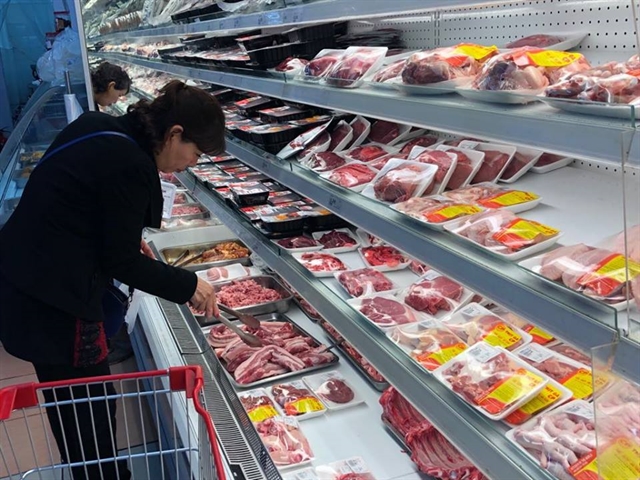 Economy
Economy


|
| A consumer choosing pork at a supermarket. There would be no shortage of pork from now to Tết (Lunar New Year) holidays. — VNA/VNS Photo |
HÀ NỘI — The Ministry of Agriculture and Rural Develop said that there would be no shortages of pork between now and the Tết (Lunar New Year) holidays.
The supply was abundant as 16 large pig-raising enterprises, which altogether accounted for nearly half of the total pork supply to the market, maintained good production and farmers across the country maintained herds of over 28 million pigs.
Due to abundant supply, the prices of live pigs were falling to below VNĐ60,000 per kilo.
According to the Ministry of Industry and Trade, live pig prices were falling since late November due to a slowdown in purchasing power while the supply was abundant.
Prices of live pigs fluctuated around VNĐ 52,000 – 56,000 per kg in the second half of November, VNĐ2,000-3,000 per kg lower than the end of October.
The ministry said the demand for pork might increase closer to Tết holidays, which would push up pork prices but the increase would not be considerable.
In late November, Deputy Prime Minister Lê Văn Thành asked the Ministry of Agriculture and Rural Development to study the proposal of exporting pigs and pork to save the domestic prices from falling and raise measures to promote sustainable husbandry.
The ministry asked provinces and cities to closely watch market developments, recommend farmers to re-herd properly and find ways to lower input costs to ensure profit for farmers
The ministry is also working with the Ministry of Industry and Trade to raise solutions to promote sustainable husbandry.
According to Nguyễn Xuân Dương, Deputy President of the Animal Husbandry Association of Việt Nam, given the current live pig prices, farmers did not have profits. He said it was necessary to seek measures to promote consumption and lift prices so that farmers could earn reasonable profits to maintain stable production.
Promoting the export of pork could be an effective long term solution, Dương said.
Deputy Director of the Department of Livestock Production Tống Xuân Chinh said prices and developing safe husbandry areas were major barriers to the official export of pork
He pointed out that currently Việt Nam did not have disease-free pig raising facilities or areas compliant with the standards of the World Organisation for Animal Health.
High production prices (around $3 per kg) also made it difficult for Việt Nam’s pork to compete with other countries (such as $1.1 of the US).
Another problem was that Việt Nam was heavily dependent on imported animal feed, making it difficult to lower pig prices as animal feed accounted for 65-70 per cent of the pig raising cost.
While the domestic supply was abundant, Việt Nam still spent nearly $200 million to import 89,000 tonnes of frozen pork in the first 10 months of this year, a decrease of 39.6 per cent in value and 34.4 per cent in volume over the same period last year,
Meanwhile, Việt Nam’s pork export was modest, just 1,000 tonnes worth $5.77 million in the January-October, mainly to Hong Kong and Laos.
The Import – Export Department said that Việt Nam’s pork export remained too modest compared to the country’s total output, due to limitations in processing, market forecast and disease prevention as well as high production costs.
The agriculture ministry said that focus would be placed on building disease-free husbandry areas to promote the export of husbandry products. — VNS




